Last updated on September 13th, 2023 at 06:53 am
Chinese rugs have been coveted for centuries for their intricate designs, rich colors, and fine quality. The tradition of weaving rugs in China dates back thousands of years to the Han Dynasty, with the earliest known examples being made from silk. Over time, Chinese rug makers developed their own distinctive styles and techniques that have been passed down through generations.
Today, Chinese rugs continue to be highly sought after by collectors and enthusiasts all over the world. With such a wide variety of types and styles available, it’s important to understand the differences between them in order to choose the right rug for your space or collection.
The Beautiful World of Chinese Rugs: A Brief Overview
Understanding the Different Types
There are several different types of Chinese rugs to choose from, each with its own unique characteristics and history. Traditional Chinese rugs are perhaps the most recognizable type, featuring classic designs and motifs that have been used for centuries.
Contemporary Chinese rugs offer a modern twist on traditional styles with bold colors and innovative designs influenced by Western design trends.
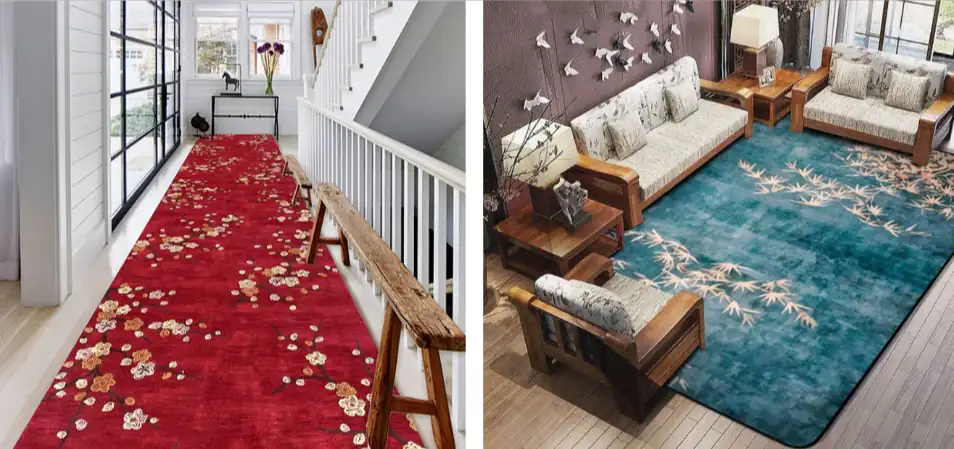
Silk rugs are another popular choice among collectors due to their luxurious nature and delicate weave.
Antique Chinese rugs offer a glimpse into China’s rich cultural heritage through rare pieces dating back hundreds of years.
And finally, Tibetan rugs are an intriguing hybrid between traditional Chinese rug-making techniques and Tibetan symbolism.
In this article, we’ll explore each type in more detail so you can get a better understanding of what makes them unique. Whether you’re looking to add some Eastern flair to your home decor or simply interested in learning more about these beautiful works of art, read on!
Traditional Chinese Rugs
What are Chinese rugs called? Chinese rugs are commonly known as “Chinese carpets” or “Oriental carpets”. They are known for their intricate designs and high-quality craftsmanship, which have made them popular all over the world.
As the first record of rugs shows, the roots of Chinese rugs history date back more than 2 000 years.
Chinese rugs have been an important part of Chinese culture for centuries. Traditional Chinese rugs are characterized by their intricate designs, rich colors, and high-quality materials.
They are often made from silk, wool, or a combination of both. The traditional techniques used to make these rugs have been passed down through generations and remain popular today.
What are the characteristics of Chinese rugs?
One of the most distinct characteristics of traditional Chinese rugs is their intricate designs. These designs often depict scenes from nature or legends and myths from China’s long history.
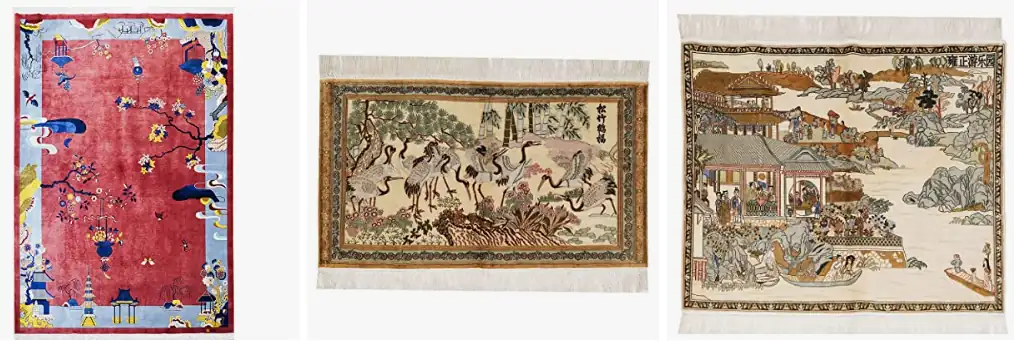
Traditional Chinese rugs also feature bold colors such as red, yellow, blue, and green, which symbolize good fortune, prosperity, and happiness.
Another characteristic is the high-quality materials used in their production.
Woolen fibers sourced from sheep raised in high-altitude regions are hand-spun into yarns that are then dyed with natural plant-based dyes. The silk used to weave the rug is also of superior quality that creates an unmistakable sheen on the surface.
Popular designs and motifs
Traditional Chinese rug designs incorporate various motifs that reflect the country’s rich cultural heritage: dragons symbolize power, success, and good fortune; phoenixes represent beauty; peonies signify wealth; bats connote happiness; lotus flowers denote purity.
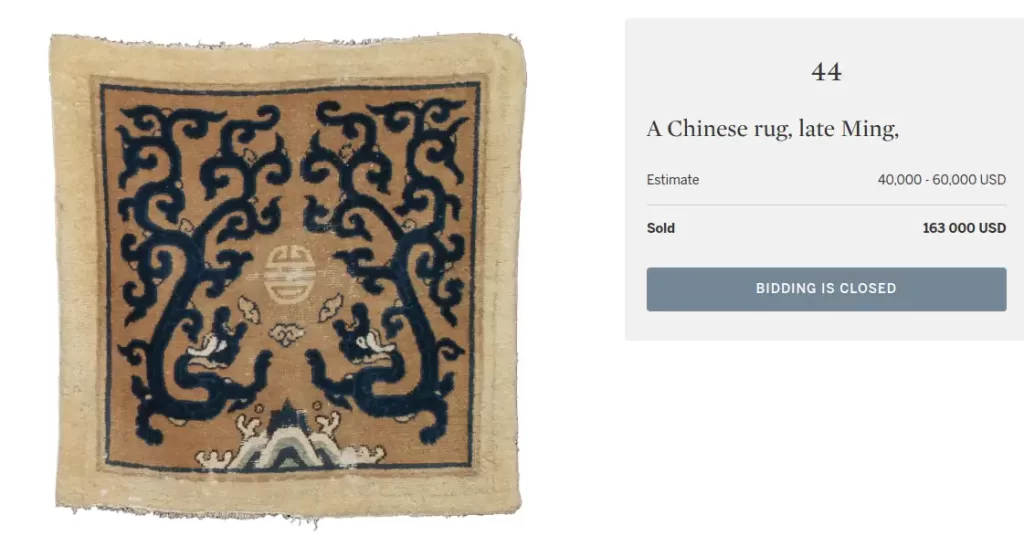
These motifs are often incorporated into patterns such as the “five-clawed dragon“, which has five toes instead of four thereby denoting imperial rank during ancient times.
Floral patterns like “blossoming peony” often adorn traditional rugs to represent prosperity while depictions of landscapes show natural beauty in a more abstract style including mountains symbolizing strength on one side while waterfalls signify change on another.
Also, patterns found in Chinese rug types may originate from Taoist or Buddhist symbols.
Differences between Northern and Southern styles
There are two main regions where these traditional Chinese rugs come from: northern China and southern China.
The major difference between the two styles is the materials used. Northern China’s rugs are typically made from wool, while Southern China’s rugs often have silk in their composition.
The color palette also varies; some regions tend to have a more muted color scheme, while other rugs showcase bolder hues. Traditional Chinese rugs hold an important place in the country’s cultural heritage.
The intricate designs and high-quality materials make them not only beautiful but also valuable works of art.
As you consider purchasing or collecting a traditional Chinese rug, be sure to keep these characteristics and differences in mind to choose the best one for your home or collection.
The Emergence of Contemporary Styles
In recent years, contemporary Chinese rugs have become increasingly popular. These rugs often feature modern designs and color palettes that depart from the traditional styles of Chinese rug making.
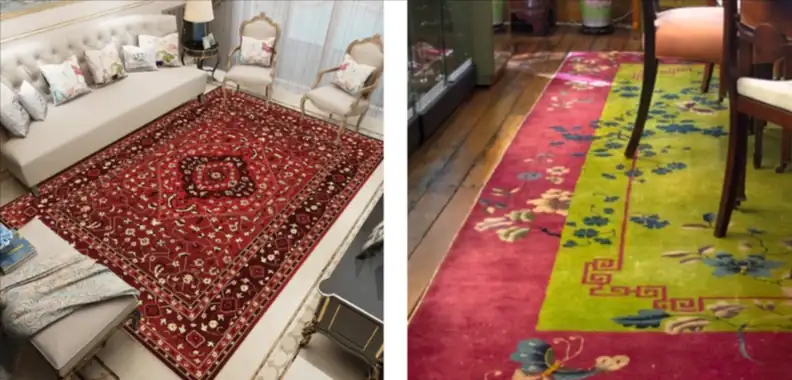
This shift towards contemporary styles can be attributed to a number of factors, including changes in consumer tastes and the influence of Western design. One factor driving the emergence of contemporary Chinese rugs is changing consumer preferences.
Many buyers today are looking for unique, one-of-a-kind pieces that reflect their individual styles and taste.
As a result, there has been a growing demand for modern and abstract designs that break away from traditional motifs like dragons and flowers.
What are Chinese rugs made of: The Luxurious Nature of Silk Rugs
Of all the different types of Chinese rugs, silk rugs are undoubtedly the most luxurious.
Silk has a history of over 5 000 years and is believed to have originated in China during the Neolithic era. Due to this, China has gained a reputation for crafting some of the world’s most exquisite silk rugs.
These elegant masterpieces are crafted entirely by hand from the softest and most lustrous silk fibers, giving them a unique texture and sheen that is simply unmatched by any other type of rug.
The intricate designs and patterns on silk rugs are often inspired by Chinese legends and myths, making them not only beautiful but also rich in cultural significance.
Silk rugs also have a very fine weave, which means they are incredibly detailed and delicate.
Silk handmade Chinese rugs

The luxurious nature of these rugs is reflected in their price tag; they can be quite expensive due to the high-quality materials used in their production.
However, for those looking for a statement piece that truly embodies luxury and elegance, a silk rug is definitely worth considering.
Production Process and Materials Used
The process of making a silk rug is incredibly time-consuming and requires great skill and attention to detail.
First, the silkworms must be carefully cultivated to ensure that they produce high-quality silk fibers. These fibers are then harvested, cleaned, dyed, spun into thread, and woven by hand onto a loom.

One reason why silk rugs are so expensive is that it takes so much time to make just one rug – often several months or even years depending on its size and complexity.
Additionally, only expert weavers with years of experience can create these intricate designs with such precision.
It’s important to note that not all “silk” rugs are actually made entirely from pure silk fibers; some may contain blends of other materials like cotton or wool. When purchasing a silk rug, make sure you do your research to ensure that you’re getting what you pay for.
Antique Chinese Rugs:
Rarity and Value of Antique Chinese Rugs:
Antique Chinese rugs are highly sought after by collectors around the world due to their rarity, exquisite craftsmanship, and historical significance.
The value of these rugs is determined by a number of factors including age, condition, size, design, and cultural significance. Some of the most valuable antique Chinese rugs have sold for millions of dollars at auction.

The rarity of antique Chinese rugs can be attributed to several factors. For one, many were destroyed during China’s Cultural Revolution in the mid-20th century.
Additionally, many were exported out of China during the 19th and early 20th centuries which means that they are located all over the world today.
As a result, finding an authentic antique Chinese rug in good condition can be quite challenging.
Historical Significance and Cultural Context:
Antique Chinese rugs hold great historical significance as they provide a window into China’s rich cultural past. These rugs were often commissioned by wealthy families or important government officials who wanted to showcase their power and status through intricate designs featuring dragons, phoenixes, flowers, or other motifs.
Identification Criteria for Authentic Antique Rugs:
Identifying an authentic antique Chinese rug can be difficult as there are many high-quality reproductions on the market that can easily fool even the most experienced collector.
There are several key factors to consider when trying to determine whether a rug is authentic or not including:
- 1. Age – Antique Chinese rugs are typically over 100 years old
- 2. Materials – Authentic antique Chinese rugs are made from silk and/or wool
- 3. Design and Motifs – Traditional designs featuring dragons, phoenixes, clouds, flowers, or other auspicious symbols are typically found on antique Chinese rugs.
- 4. Weaving Technique – Authentic antique Chinese rugs are hand-knotted using traditional techniques such as the asymmetrical knot.
By carefully examining these factors, you can increase your chances of identifying an authentic antique Chinese rug and appreciating its unique historical value.
Specific types of Chinese carpets and rugs
There are some specific popular types of Chinese rugs such as:
| Ningxia rugs |
| Chinese aubusson rugs |
| Tibetan rugs |
| Peking rug |
Ningxia rugs
Ningxia rugs (Ninxia, Ningsia), a type of Chinese rug, that feature a range of traditional designs, including floral motifs, geometric shapes, and animals such as dragons and birds.
The rugs also often incorporate traditional Chinese symbols and colors, such as red for good luck and prosperity. Many Ningxia rugs feature a central medallion design influenced by Persian carpet patterns, while others have an all-over pattern or a border design. Mongolian rug motifs are also to find on the antique Ningxia rugs.
What is Ningxia? Ningxia is a region located in northwestern China known for its rich history and cultural heritage. It is also renowned for its production of high-quality wool and silk rugs, which are often referred to as “Ningxia rugs.”
During the 11th-13th century, Ningxia was the heartland that was founded by the Tangut people. The name “Peaceful Xia” was given after the Mongol conquest of the state. The Tanguts were known for their contributions in various fields including literature, art, music, and architecture, and were credited with inventing the Tangut script.
The intricate designs and high-quality craftsmanship make Ningxia rugs a popular choice for collectors and decorators alike. The antique Chinese Ningxia rugs today are a quality designation.
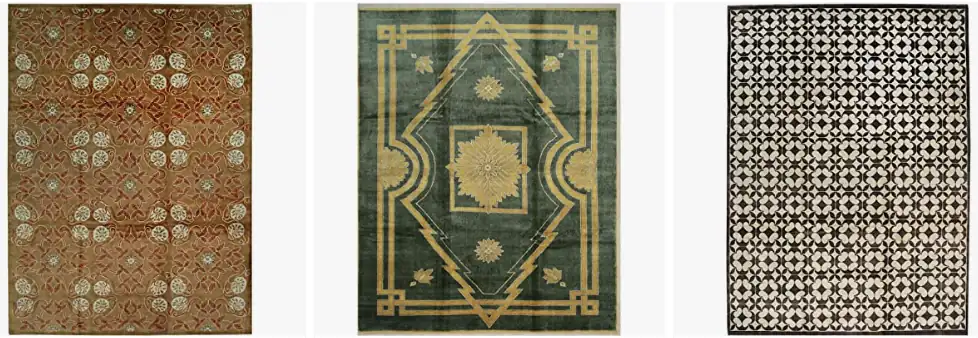
Other historical regions in China known for influencing rug manufacturing are Kansu (Gansu), Suiyang, Baotou, Peking, Beijing, Tianjin, etc.
Chinese Aubusson Rugs
What is a Chinese Aubusson rug? Chinese Aubusson rugs are a type of hand-woven rug that originated in China and are inspired by the designs of French Aubusson rugs.
These rugs are typically made with wool or silk and are known for their intricate designs and use of pastel colors. They often feature floral motifs, medallions, and ornate borders. Chinese Aubusson rugs are a popular choice for traditional home decor and can add a touch of elegance and sophistication to any room.
What is Aubusson style? Aubusson style refers to a type of flat-woven tapestry that originated in Aubusson, France, in the 16th century.
Aubusson rugs and tapestries were highly prized by European aristocrats during the Renaissance and Baroque periods and continue to be sought after today for their elegance and beauty.
Chinese Aubusson rugs appeared after the French Aubusson rug and tapestry manufacturing become a trend. Chinese rug weavers started to create their own fusion of traditional Chinese patterns and Western Aubusson rug-making techniques and designs.
These rugs were highly sought after by collectors and decorators for their exquisite craftsmanship and beauty.
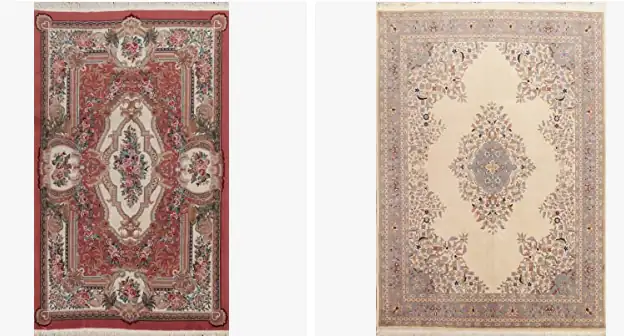
Tibetan Rugs
Tibetan rugs are a unique type of rug that is distinct from traditional Chinese rugs. They are handwoven by Tibetan weavers who have passed down their skills through generations.
Tibetan rug weaving techniques involve tying knots by hand to create intricate designs and patterns. The wool used in these rugs is typically sourced from Himalayan sheep, which produces a thick, durable wool fiber capable of withstanding harsh weather conditions.
The craft of Tibetan rug making has been practiced for centuries. Changpel, the wool of Tibetan highland sheep, is the primary material used to create these rugs. While Tibetans use these rugs in many ways, such as flooring, wall hangings, and even horse saddles, they are most commonly used as seating and sleeping carpets.
A sleeping carpet is called khaden. It measures approximately 3 ft x 5 ft (0.91 m x 1.52 m) and is an example of a traditional Tibetan rug.

Unique features of Tibetan rug weaving techniques
Tibetan rug weaving techniques differ from traditional Chinese rug styles in several ways. Firstly, the knot used in Tibetan rugs is different – it’s called the Tibetan knot.
This gives Tibetan rugs a unique texture and more defined patterns compared to traditional Chinese rugs. Additionally, some weavers use high-altitude sheep wool for their rugs, which makes the yarn stronger and more resilient.
Another unique feature of Tibetan rug weaving is the use of natural dyes to create vibrant colors that are resistant to fading over time. These dyes are made from natural materials such as plants, insects, and minerals found in the Himalayan region.
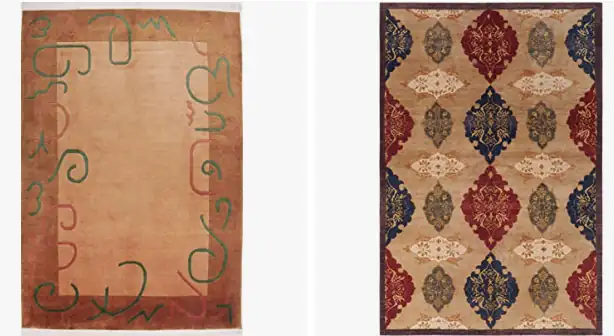
Differences between Tibetan and traditional Chinese rug styles
There are several differences between Tibetan and traditional Chinese rug styles beyond just the knotting technique used.
For example, Tibetan rugs often incorporate bold geometric designs with bright colors whereas traditional Chinese rugs tend towards floral motifs with more subdued color palettes.
Additionally, while both types of rugs may be made from wool or silk fibers, the thickness of these fibers differs between them. Wool fibers used in Tibetan rugs tend to be thicker than those used in traditional Chinese Rugs resulting in a sturdier feeling underfoot but less delicate draping over furniture.
What are the symbols on Tibetan rugs
Tibetan carpets often have cultural or religious motifs, such as dragons, tigers, or flowers, that imbue them with deeper meanings. Symbols can also represent various aspects of life from health to prosperity.
These rugs are not just pieces of decoration but often hold deep cultural and religious significance for the Tibetan community. For example, some Tibetan rugs may feature the “Eight Auspicious Symbols” (Ashtamangala) which are believed to bring good luck and prosperity to those who own them.
Other designs may include the “Yin-Yang” symbol which represents balance and harmony in life. Tibetan rugs offer a unique alternative to traditional Chinese styles with their bold patterns and cultural symbolism.
They are made with a distinct knotting technique that imbues each rug with a special texture and resilience. Understanding these differences will help you choose the right type of rug for your home or collection based on your preferences or needs.
Chinese Peking rug
What is a Peking rug? A Chinese Peking rug is a type of hand-woven carpet that originated in Beijing, China during the late 19th and early 20th centuries. These rugs are made from high-quality wool and silk and are known for their intricate designs and vibrant colors.
They were popular among royalty and aristocrats in Europe and America during the early 20th century and continue to be highly sought after by collectors and enthusiasts today.
Peking rugs
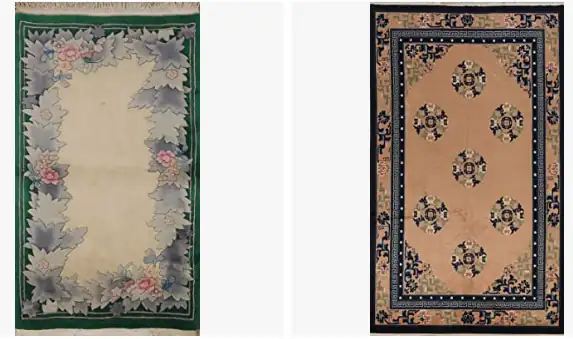
Conclusion
Recap of the Different Types of Chinese Rugs
In this article, we have explored the various types of Chinese rugs, from traditional to contemporary styles.
Traditional Chinese rugs are characterized by their intricate designs and motifs, which often incorporate auspicious symbols and nature-inspired patterns. Contemporary Chinese rugs, on the other hand, feature modern designs and color palettes that reflect Western influences.
Silk rugs are incredibly luxurious and prized for their softness and shine. They require special care to maintain their beauty and longevity.
Antique Chinese rugs are rare treasures with significant historical value. Tibetan rugs have unique weaving techniques that produce thick pile carpets with a distinct look.
Importance of Choosing the Right Type for Your Space or Collection
When selecting a Chinese rug for your space or collection, it is essential to consider its intended use and style as well as the materials used in its production.
Traditional Chinese rugs can add an elegant touch to any room while also providing historical context.
Contemporary Chinese rugs offer more versatility in terms of design but may not hold the same cultural significance as traditional styles. Silk rugs provide a luxurious option for high-traffic areas like living rooms or bedrooms but may be less practical in more casual spaces like dining rooms or kitchens.
Antique Chinese rugs are excellent investments for collectors who appreciate their rarity and historical significance. Tibetan rugs can add warmth and texture to any space while also incorporating meaningful symbolism into their designs.
Understanding the different types of Chinese rugs is crucial when choosing the right one for your space or collection. Whether you prefer traditional elegance or modern versatility, there is a perfect type of rug out there waiting for you.




